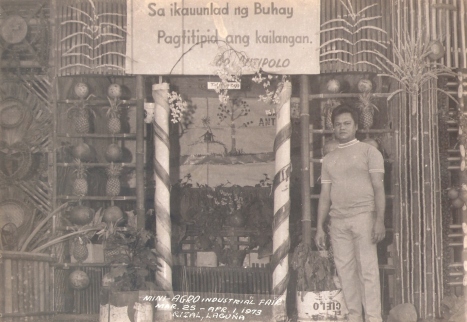BARANGAY ANTIPOLO
Antipolo is one of the largest barrios in the town of Rizal, Province of Laguna. It is located in the Western part of the town, a kilometer away from the Poblacion. This barrio is along the provincial road leading to San Pablo City. It serves as a boundary line of Rizal and San Pablo City.
Apprehension of information reveals that this barrio was established when our town, formerly known as Pauli, was separated from her mother town, the town of Nagcarlan, Laguna. Antipolo is the ancient name of this place because of the huge Antipolo tree in that place, that guided and gave shed to travelers who were resting under it before going down the muddy road of Biuyan.
This barrio which had been derived from the symbolic Antipolo tree was inhabited by few families. The original families who were they bases of improvements were Pedro Urrea’s Family, Manuel Author’s family, Eleuterio Laycano’s family, Eladio Sumatra’s family and the Silvestre Laycano’s family. This group of families worked together, lived together peacefully under the leadership of their barrio lieutenants from the very beginning up to the present date, Those who guided and led them in their activities were Senon Urrea, Silvestre Laycano, Eladio Sumatra, Jose Urrea, Reymondo Isleta, Ladislao Formales, Leon Autor, Igmedio Royo, Pedro Sumatra and Teofilo Isleta.
This barrio of Antipolo is a congregation of different sitios. The different sitios that composed the barrio are: Punong-halang, Sabutan, Tabla, Pauli and Kalibato. These sitios under the jurisdiction of Antipolo were named by the early inhabitants depending upon the events that happen on that place and upon the products raised. The sitio of Pulong-halang was so named because it was the hiding place of the “Manghaharang” after robbing the travelers on the difficult road at Biuyan, Sabutan is another sitio of Antipolo, it has been named after the Sabutan plant raised on that place and according to some old people it was also called that name for it was the place where robbers met to trade their kidnapped persons or things for the expediency of their barbarous business.
It was the so-called “Sabutan” ng mga hinarang ng mga nanghaharang.
This sitio was once made a camp of the guerilla units during the Japanese occupation. Pauli is another sitio of the barrio Antipolo got its name from the stream that flows back and forth of “Pauli-uli”. Tabla a sitio of the same barrio is a historical spot. It had been the guarding place or outpost of General Juan Cailles faithful soldier during the Filipino-American War. It had been named Tabla, because of the lumber or “table” produced from that place when it was still a wilderness. The most important sitio of Antipolo is what we called Kalibato, for it had been the source of living of the inhabitants of the nearby barrios. There is a legend about it that runs. Long time ago, this place was a farm of a couple named Kali and Berta. This couple were living happily, contented of their lives for they have sufficient food to support their living. One day an old woman came, begging for food. When Kali saw the rugged woman he drove her away with the help of his dog. To protect herself from being bitten by the dogs she threw stones to them and said, “May God punish you for your selfishness”. Berta said “Kali, bato”, Kali placed up the stone thrown by the old woman. When Kali was holding the stone to be thrown back to the old woman a roaring sound was heard. And after the strange sound, the place where Kali was standing sank and became a lake. When the neighbors asked Berta what happen she said, “I just shouted Kali, Bato, then the place where Kali was standing sank after the roaring sound. Thus, Kalibato got its name.
This barrio is very fortunate for it had been free from destruction of lives and properties during the past wars.











No comments:
Post a Comment